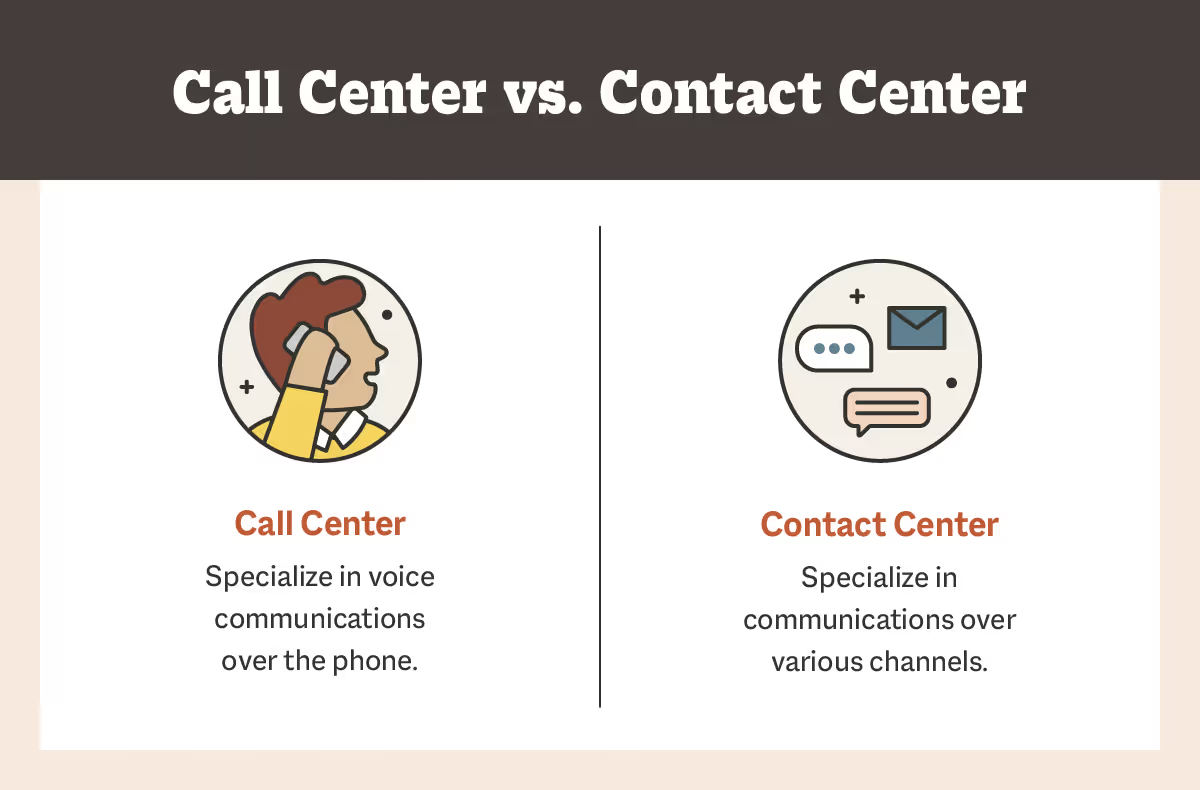What Is a Call Center? Plus 10 Call Center KPIs To Track for Success
What Is a Call Center? Plus 10 Call Center KPIs To Track for Success

Whether you are selling a good or service, or even trying to promote it, you need to establish a channel of communication with your customers. That’s why a call center is a necessary component of operating practically every customer-focused organization.
In fact, it is predicted that by 2027, the global market for call centers will be worth $496 billion.
So what exactly is a call center? We'll go over everything you need to know about call centers, including the different types and the crucial metrics you need to track for company success.

Call center definition
A call center is a type of answering service handled by an outsourced organization that specializes in sales, marketing, and customer support. Usually, they deal with a lot of calls about availability of services, order status, and product features.
Interactive voice response (IVR) systems can manage many of these calls by allowing callers to quickly obtain specific information and serve themselves. Other callers need a human agent's help to respond to their inquiries, answer questions, or take care of their specific needs.
Since phone support is the primary means of communication between customers and businesses in conventional customer service models, these support teams are known as "call centers."
However, in today’s age of digital transformation, the call center landscape has changed in response to technological developments and shifting consumer behavior. With these advancements, a new term, “contact center” has emerged to replace the traditional call center.
Call center vs. contact center
The main distinction between a call center and a contact center is that call centers specialize in voice communications over the phone while contact centers work with all types of communications.

In reality, there are many other ways to connect with customers aside from the phone. The long-standing traditional call center model is changing due to the trends of rising consumer expectations and modern technologies that enable many channels of communication. Businesses are seeking for new methods to enhance the customer experience while consumers desire more ways to contact businesses.
Because of this, many call centers have made the shift to become contact centers by adding other forms of communication to their service offerings including, email, and live chat.
Types of call centers
There are three main types of call centers — inbound, outbound, and virtual. Some call centers only offer a specific purpose while others blend these functions. We’ll walk you through what each type of call center can do.

Inbound call center
An inbound call center handles incoming calls from current and potential customers. These types of call centers are customer service-focused, with a majority of their calls dealing with:
- Account management
- Technical support
- Customer complaints
- Scheduling
- Queries about products or services
These call centers often receive a sizable volume of incoming calls and then screen, forward, and log the calls. If you decide to invest in an inbound call center, you'll benefit from software that gives you access to capabilities like an interactive voice response, efficient call routing, and call recording.
Outbound call center
In an outbound call center, representatives reach out to current and new clients on the phone on behalf of the organization. These types of call centers are usually sales-oriented, making calls for tasks such as:
- Market research
- Lead generation
- Telemarketing
- Payment collection
- Customer service surveys
- Customer retention
- Follow-up calls
If you invest in an outbound call center, you’ll benefit from technology like call or dialer monitoring features.
Virtual call center
An AI-assisted virtual contact center, like Smith.ai, uses virtual receptionists is similar to the typical inbound and outbound call centers, except the centralized location isn’t in a physical place like an office. Instead, a virtual call center has virtual receptionists working from remote locations where they can use VoIP (Voice over Internet Protocol) software to access cloud calling, messaging, and email rather than taking calls on landline phones.
A virtual contact center like Smith.ai uses virtual receptionists which can blend both inbound and outbound call functions with added benefits, including:
- 24/7 phone answering
- Outreach campaigns
- Appointment management
- Lead generation
- Lead screening and intake
- Outbound call-backs
- Warm call transfers
- Payment collection
- Overflow answering
- Free spam blocking
- 24/7 live chat
This virtual model is extremely efficient, and all of the information from each contact can be logged into your company’s CRM (customer relationship management) software. Any authorized personnel has access to the most recent account history and client interactions because all data is saved in the cloud.
A virtual call center is also significantly less expensive than a traditional call center or hiring an internal receptionist team. If you opt for a virtual call center solution like Smith.ai, you pay per call, not per minute, so monthly bills are predictable and don’t go up or down based on chatty callers.
10 Call center KPIs to measure for success
Since you now understand what a call center is and the various types that exist, you should be aware of the key performance indicators (KPIs) that are critical to track to measure success.

The following are some popular call center metrics to monitor:
1. First response time (FRT)
First response time (FRT), also known as average speed to answer, calculates the average time it takes for agents to answer calls.
The goal is to keep this metric as low as possible to prove that your customers barely have to wait for their issue to be resolved. The faster a customer can be responded to and helped, the higher their satisfaction rate will be.
A highly responsive business also earns more leads. If you don't immediately follow up, those customers will go to a competitor. In fact, following up with leads within the first minute of their contact increases lead conversion rates by almost 400%.
Ideal KPI level: Low
2. Average handle time (AHT)
The average handle time (AHT) measures the average amount of time between when an agent picks up the phone and when the call is disconnected.
With this metric, the shorter the AHT, the quicker the issues raised by your customers are remedied. However, some customers’ inquiries may be more complex than others, requiring more time to be handled properly, so it's important to remember that the quality of service is more important than keeping the AHT low.
The trick is to determine the least and greatest amount of time needed to identify, handle, and solve the typical problem, maintaining the duration of each call somewhere in this range to ensure customers are handled properly.
If you notice your AHT is increasing, this could be an indicator that your agents need more training and support.
Ideal KPI level: Low to mid
3. Average abandonment rate (AAR)
The average abandonment rate (AAR), which is a popular KPI in call centers, reveals the percentage of customers who hang up before speaking with an agent.
This includes instances when clients end their calls while they are waiting in the queue or listening to the IVR menu options. Call abandonment can also occur when a caller is connected directly to voicemail rather than an agent.
For this metric, the lower your AAR is, the better. No matter the cause of your customers hanging up, it's crucial to record these dropped calls.
Whether your clients are purposefully ending calls (by choosing to hang up), are being routed to voicemail, or are being disconnected automatically, you must ascertain the cause if callers are unable to connect to your call center so that you can make the necessary changes.
Ideal KPI level: Low
4. Average speed of answer (ASA)
The average speed of answer (ASA) measures how quickly your agents are able to provide solutions to your customers’ issues.
Although it is related to AHT, this KPI relates to the overall time an agent spends researching the precise response a customer requires, not the amount of time spent between the time an agent answers an incoming call and the call's conclusion.
You’ll want your ASA to be as low as possible to ensure high customer satisfaction. It will be simpler for an agent to reduce their ASA the more skilled and experienced they are. Agents who are knowledgeable about a wide variety of solutions will be able to respond to a customer's inquiry more swiftly.
Ideal KPI level: Low
5. Average time in queue
The average time in queue lets you know how long callers are kept waiting on hold in call queues. Nobody likes long wait times, so keeping this metric low is always better.
When you experience high call volume during peak hours, it can be challenging to accomplish this. These things do happen, but if you discover that your customers are frequently spending a long time waiting to be answered, it may be a sign that you have a staffing problem.
You can fix this by either hiring more agents or increasing the productivity of your current support team.
Ideal KPI level: Low
6. Average after-call work time (AWT)
The average after-call work time (AWT) tracks and measures the average time it takes agents to do the work associated with a call after it's finished.
Customers frequently contact to report problems that don't necessarily require immediate attention or solutions. Even while these issues still need to be resolved, your representatives don't necessarily have to keep callers waiting.
Agents occasionally have the ability to highlight problems they need to fix, hang up, and then take care of the solution. It benefits everyone when callers' overall average hold time decreases and agents can provide a more simplified customer experience.
You’ll want to make sure these metrics are kept low, but not low enough that the quality of service is decreased.
Ideal KPI level: Low
7. First call resolution rate (FCR)
The first call resolution rate (FCR) tracks the percentage of calls where the agent can address a caller's issues without transferring, escalating, or returning the call.
You’ll want to keep your FCR as high as possible, which will lead to higher customer satisfaction. The fewer times your agents need to call back a customer to solve an issue, the better.
However, that’s not always the case, as some customers may not have the information needed to solve the issue on the first call. That's not ideal for your FCR rate, but it's also not indicative of how well your customer service is provided.
Ideal KPI level: High
8. Occupancy rate
Occupancy rate metrics indicate how much time agents are on live calls or finishing up work related to those calls. It's the percentage of time agents spend on call-related activities, including taking calls and AWT.
You should maintain a high occupancy rate, ideally between 75% and 90%. Anything less than 75% indicates underperformance and the need to boost agents' productivity.
Anything beyond 90%, on the other hand, indicates that your agents aren't using the time they have in between calls to do other things like write down notes after a contact or do other tasks that will improve the level of service they offer like training sessions.
Ideal KPI level: High
9. Percentage of calls blocked
The percentage of calls blocked is a metric that measures the proportion of authentic inbound calls which do not reach an agent because they are deliberately disconnected by your phone systems.
Unfortunately, call centers are not immune to spam calls. Call centers have had to adjust by implementing call-blocking software, as the arrival rate for these types of phone calls keeps increasing.
You’ll want to keep this percentage low, as spending even a brief amount of time on the phone with spammers means losing out on potential customer interaction time. It’s always better to track how many (and what proportion) calls your software is able to block.
After all, you want to be able to share that your agents give all of their attention to callers who truly need their help and spend no time on scammers.
Ideal KPI level: Low
10. Customer satisfaction (CSAT)
The goal of your customer satisfaction rate (CSAT) is to gauge how pleased your clients are with the support they have received.
Customers are typically surveyed directly after a call to determine their opinions of your call center's service in order to calculate CSAT. After being given the chance to submit comments, they will be asked to score their overall experience.
You can observe how your agents are doing in real time based on their CSAT scores. Of course, you want to make sure these scores are as high as possible to ensure that your customers are actually satisfied with their experience.
However, a major problem with this specific metric is that most customers don’t fill them out. Typically, only the happiest and angriest customers will fill out a CSAT, which means your CSAT answers are likely to be very skewed and not representative of how your customers feel overall.
That’s why it’s important for call centers to have a call recording and transcripts feature that automatically records your calls so you never miss what your customers have to say. Listen to your callers, or read and search their exact words, from any conversation so you can improve the overall customer experience.
Ideal KPI level: High
Choose a better alternative to call centers with Smith.ai
Running a business is a full-time job, and then some. Smith.ai can lighten the load by handling all your call center service needs — with an even better solution. Smith.ai is a better alternative to call center services, using live professional North American virtual receptionists to help manage your business communications and accelerate growth.
With our virtual receptionists, you can have your bases covered around the clock rather than outsourcing to a generic call center with operators who typically allow your after-hours inquiries to go directly to voicemail.
Smith.ai gives you a team of 24-hour live remote receptionists; this is far better for your company and your customer relationships than scripted, robotic-sounding contact center representatives.
Schedule appointments, welcome new clients, assist loyal customers, cultivate a better customer experience, and free up time for what matters most: the wonderful job you perform for your clients and customers. All of this can happen without you ever picking up the phone (unless you agree to call transfers).
To learn more about Smith.ai and what our services can do for you, book a free consultation today.
Sources: Small Biz Genius
Take the faster path to growth. Get Smith.ai today.
Key Areas to Explore
Technical Implementation Terms
Voice user interface (VUl) design
Speech recognition integration
Text-to-speech optimization
API connectivity and webhooks
Real-time data synchronization

Your submission has been received!









%20(1)%20(1).avif)



%20(1)%20(1).avif)
.svg)



